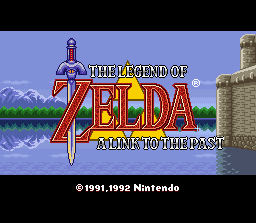

Game Analysis- Zuzanna Devey-Halik
in 1992 Koji Kondo, Nintendo's in-house game designer, did it again with another one of
the most popular video games of all time. . . Zelda "A Link to the past" for the SNES.....
Zelda is a role -play game that relies on mystery solving, exploration and good old fashioned
sword battling. It is a fairy story, and it is being written as you adventure.
This is the draw of the game.
You are Link, a young pixie-esque type male, who, despite his fathers wishes of staying
at home,ventures out and into a whole heap of trouble.
The land has been taken over by an evil wizard Agahim, he has captured princess
Zelda and cast a spell on Hyrule, the land you live in.
Your mission is to find Zelda and rescue her, destroying evil and returning tranquility
to the land.
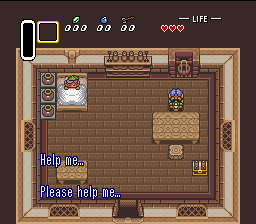
Link having a dream of zeldas capture
The Interface
the interface is very simple to read. You have a window for displaying each of the
following:
these are placed at the top of the screen, small enough not to get in the way. You have
options for change in the pull down menu.
Controls
left/ right/ up/ down/ pick up/ push/ throw/ collect/pull/talk/read/run.
Because of the lack of numerous buttons on the SNES, they multi- function depending
on what you are standing in front of, or happen automatically if you are in close proximity.
Some of these actions you have to earn along the way, like magic run shoes or iron glove for pulling.
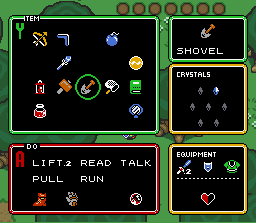
Pull down menu
time
there is no time limit to Zelda.
As it is an adventure exploration game you can save where you end off.
At the beginning you are offered a menu of 3 existing games to resume, or if there is space
a new game from scratch.
To proceed you must enter your name.
This lets the game be saved in your slot under you and also tailors the games narrative
speech to you, so when people speak they call you by name.
Time is only an issue when you are fighting baddies as this is a confrontational situation
and the faster you win the less chance of damage to your life reserves there are. Also a
few perishable items exist,such as uncovered hearts and money,and magic potion. If you find
it, eat it. You can't save it for later.
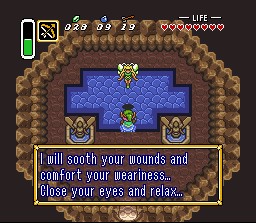
I bet you will .......
Physical components
this is a define and use game.
You collect things as the game progresses which you later have to use. Some are hidden
and some presented in chests.
It is in your interest to spend time looking in nooks and crannies for certain objects.
You start with nothing but three hearts for life force. You find more on the way. Heart replenishers
are found under rocks or as reward for slaying baddies,( when you have found your sword).
you can buy life force from the shop with your money.
If you are lucky enough to find or get given empty jars, when you find the faerie cave you can
bottle them and eat them later for life force, or they give you a second chance at life when you die.
There is also such a place for money. You can collect loads at a time and then go to the shop
and buy your goods.
....And a fairy cavern of ill repute, where you recharge you energy levels..
You collect a variety of weapons and tools,thank god, as the wooden sword you have at
the beginning is rather pitiful.
There are also medallions and crystals to collect.
Magic potion is found in little sacks throughout the game, either under unsuspecting bushes
or given as a reward from dead enemies. You can also buy a recharge potion sack from the
shop but this is rather expensive.
You must have sufficient potion to utilise your magic tools.
Levels
there are no defined levels as such,they take the shape of chapters.
These chapters are either narrative or functional. They are interwoven throughout the game.
Narrative:
after defeating a boss you gain a medallion.
There are three to collect and together they open up the Dark world.
The Dark world is a place the same but different. You navigate the same map but the creatures
are weird and the landscape deadened.
Here, you collect eight crystals which break the spell, allow you entry to the big bad ending
where you fight for your beloved Zelda.
These tell the story.
The others are functional:
you solve puzzles and defeat baddies and gain items that improve your interactivity or strength
within the game. These are sub-levels like land marks.
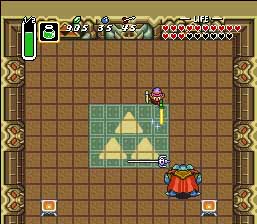
Ergonomic concerns
Your arena of play is the map of Hyrule, which you use to navigate your way about the land.
This land consists of mountains, forests a town and a desert, littered with castles and huts and caves etc.
Each screen is a close up of this map. You move inside each screen freely, the screen moving
to the next section of the map when you are at the edge of the screen shot, so you exit left/ enter right
or exit bottom/ enter top. The screen does not pan with you as you move.
The characters are shown from the side flat , but curiously from the front at a three quarter aerial view.
You also have a full aerial view of the land, mixed with three quarter view graphic such as houses etc.
press down and you walk toward the screen, press up and you walk away into the distance.
The mountains are displayed as ascending and you walk down stairs to the dungeons bellow ground .
This bizarre mix of unorthodox perspectives actually creates a fascinating 3D belief in your mind,
and you understand easily how to move around this illusion of depth and space.
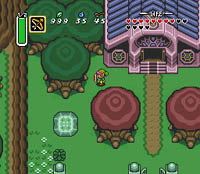
Flow of the game
you are confined to the area of play as much as the physicality of your environment. You cannot
progress beyond certain points without interacting with certain characters or places.
Choice options are minimal, it is quite easy to get it right. The emphasis is to find things out more
than make any strong decisions.
The game takes about 30 hours to complete and is very entertaining.
You have payoffs regularly so you feel progression and the different places on the map are visually
different enough as not to get bored.
Classic easy gameplay is at work here, no complex combo moves that utilise more fingers for frantic
button pressing than we physically have, just a bit of thought and a stroll through the woods.....
sound and script
characters talk to you by way of writing on the screen, which you prompt at your own time. These are
clues to what to do next and they also give you a sense of storytelling.
The music and sounds are well designed , not annoying or forceful.
You get a variety of different backing tracks at different stages in the game, to add a sense of atmosphere
and get your heart going,( as the cartoony boss men are not really that scary).
the noises are relevant, ka-chings for money collection and fill up warbles for potion increases plus
many more.
Without these 2 elements the game would be unplayable.
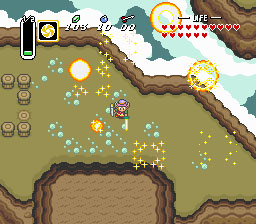
Clarity of strategy
your primary objective is to rescue the princess.
you learn your strategy pretty quickly, tactically caution is the best policy.
Kill your enemies as you go, otherwise they follow you dumbly round the screen. Over the long
term this is in your interest.
As a secondary objective Collect things as you need them, if you know from a previous game
of something hidden but you don't need it now, don't uncover it as it will perish . remember
where it is and go back when you need it.
Enter a boss lair prepared. There is nothing more frustrating than dying and having to do the
whole dungeon again to get to him.
These things you learn five minutes into the game and they remain the same throughout.
Age group
Zelda is aimed at teens to late adulthood. It is a little to complex for younger children as there
is guesswork to be done and this involves spending time thinking things through, so you need
a little patience.
Zeldas peers
Zelda on the SNES was really unrivaled at the time of its arrival.
Super Mario Land was THE platform game of choice, and the SNES seemed to be the ideal
console for platform games. Racing games had a go but the only one to stick out was Mariocart,
riding on the back of its popularity with the characters.
Zelda was THE adventure game of choice, others such as Mystic Quest did not have the cute
graphics or the user friendly game play. An adventure game of this proportion on the SNES seems
to us hungry gamers like too bigger task to take on, mainly for all the troubles you would have to
resolve to do it right, but Zelda 3 has a perfect balance of all things great about gaming. This is
why Zelda is still so successful,because Zelda 3 made its mark.
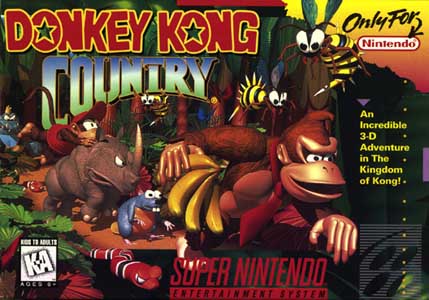
New look platform donkeykong for the SNES.
Historical and contextual concerns
Zelda is a distant cousin of the fairytale.
It is not documented where legends really come from, we assume they are stories passed on by
word of mouth as entertainment before consoles were invented...
what we do know is they bring a sense of mystery to the listener, courage and woe, a sense of pride
and marvel in the hero and a feeling that good is right and evil the wrong thing to be getting on with.
This is a strong basis for want of participation.
Through the years these legends have turned into books and games such as dungeons and dragons,
the latter being possible only with a certain amount of people to play with.
Zelda 3 was the first complex graphically pleasing adventure game on a computer console, and yes,
you could play it all on your lonesome.
This is the latest incarnation of the fairytales journey in media,were will it go next....
Now and the future?
Zelda in my opinion went a bit pear shaped when it came out in 3D on the Nintendo64 as it lost its
aesthetic feel and looked pretty much like any other 3D game.
Link lost his sparkle and looked like and other tom/Dick/harry elf.
Also the 3D rotation of the navigation gave me a headache and took away from my problem solving capacity.
Good news, new Zelda is in a cartoony style once more.( Not received well in America, oh well) the
new version will be released soon . it looks fantastic.
The future I hope will see virtual Zelda, heaps more interactivity and depth.
